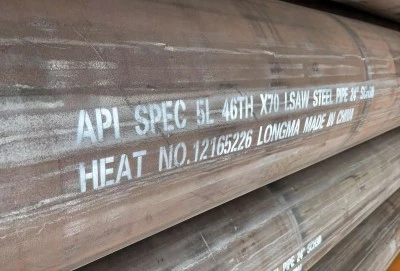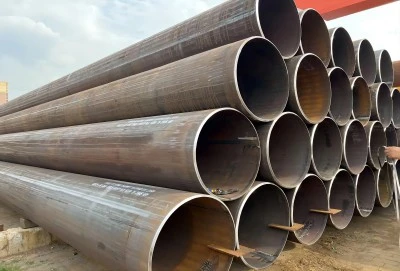API 5L welded pipes are crucial components in the oil and gas industry, serving as the backbone for transporting petroleum products across vast distances. These pipes are manufactured to meet the stringent standards set by the American Petroleum Institute (API), ensuring reliability and safety in various applications.
|
|
|
What are the main grade classifications in API 5L welded pipe?
API 5L welded pipes are classified into several grades based on their mechanical properties, particularly yield strength. The main grades include:
- Grade B
- X42
- X46
- X52
- X56
- X60
- X65
- X70
- X80
Each grade is denoted by the letter "X" followed by a number representing the minimum yield strength in thousands of pounds per square inch (ksi). For example, X80 has a minimum yield strength of 80,000 psi (551 MPa).
Grade B is the baseline grade, commonly used in less demanding applications. As we move up the scale from X42 to X80, the strength and performance characteristics of the pipes improve, allowing for higher operating pressures and more challenging environments.
It's worth noting that API 5L also specifies two product specification levels (PSL 1 and PSL 2), with PSL 2 having more stringent requirements for chemical composition, mechanical properties, and testing procedures.
How do the mechanical properties vary from Gr.B to X80?
The mechanical properties of API 5L welded pipes show a clear progression as we move from Grade B to X80. Let's examine the key mechanical properties and how they change across the grades:
1. Yield Strength
Yield strength is the primary factor distinguishing different grades of API 5L welded pipes. It represents the stress at which the material begins to deform plastically. The yield strength increases significantly from Grade B to X80:
- Grade B: 35,000 psi (241 MPa)
- X42: 42,000 psi (290 MPa)
- X52: 52,000 psi (359 MPa)
- X60: 60,000 psi (414 MPa)
- X70: 70,000 psi (483 MPa)
- X80: 80,000 psi (551 MPa)
This increase in yield strength allows higher-grade pipes to withstand greater internal pressures, making them suitable for high-pressure transmission lines.
2. Tensile Strength
Tensile strength, or ultimate tensile strength (UTS), also increases with grade, though not as dramatically as yield strength:
- Grade B: 60,000 psi (414 MPa)
- X42: 60,000 psi (414 MPa)
- X52: 66,000 psi (455 MPa)
- X60: 75,000 psi (517 MPa)
- X70: 82,000 psi (565 MPa)
- X80: 90,000 psi (621 MPa)
The higher tensile strength in advanced grades contributes to improved overall pipe performance and durability.
3. Elongation
Elongation, which measures the ductility of the material, generally decreases slightly as the grade increases. However, API 5L standards ensure that even high-strength grades maintain sufficient ductility for safe operation:
- Grade B: 23% (minimum)
- X42 to X80: 18% (minimum)
This balance between strength and ductility is crucial for maintaining pipe integrity under various loading conditions.
4. Toughness
Toughness, often measured by Charpy V-notch impact tests, is critical for resistance to crack propagation. While not directly correlated with grade, higher-grade pipes often have enhanced toughness requirements, especially for low-temperature applications.
For instance, X70 and X80 pipes used in arctic environments may require impact energies of 40-100 Joules at temperatures as low as -40°C, depending on the specific project requirements.
How does increasing grade strength impact weldability and toughness?
As we progress from Grade B to X80 in API 5L welded pipes, the increasing strength brings both advantages and challenges, particularly in terms of weldability and toughness. Understanding these impacts is crucial for proper material selection and pipeline design.
Weldability Considerations
Weldability generally becomes more challenging as the grade strength increases:
- Carbon Equivalent (CE): Higher-grade pipes often have a higher carbon equivalent, which can increase the risk of weld hardening and cracking. Manufacturers must carefully control the chemical composition to maintain good weldability.
- Preheating Requirements: As grade strength increases, preheating before welding becomes more critical to prevent cold cracking. X70 and X80 pipes may require preheating temperatures of 100°C or higher, depending on wall thickness and welding conditions.
- Heat Input Control: Higher-grade pipes are more sensitive to heat input during welding. Excessive heat can degrade the carefully engineered microstructure, potentially reducing strength and toughness in the heat-affected zone (HAZ).
- Welding Consumables: Selection of appropriate welding consumables becomes more critical for higher-grade pipes. Consumables must be carefully matched to the base metal to ensure adequate strength and toughness in the weld joint.
Toughness Considerations
Maintaining adequate toughness in higher-strength grades requires careful material design and processing:
- Microstructure Engineering: Advanced grades like X70 and X80 often utilize sophisticated microstructure engineering techniques, such as thermo-mechanical controlled processing (TMCP), to achieve a fine-grained structure that balances high strength with good toughness.
- Alloying Elements: Higher-grade pipes may incorporate additional alloying elements like niobium, vanadium, and titanium to enhance strength and toughness. However, these elements must be carefully balanced to maintain weldability.
- Heat-Affected Zone (HAZ) Toughness: As grade strength increases, maintaining adequate toughness in the HAZ becomes more challenging. Welding procedures must be carefully developed and qualified to ensure that the HAZ meets the required toughness specifications.
- Low-Temperature Performance: Higher-grade pipes, especially those intended for arctic or offshore applications, often have more stringent low-temperature toughness requirements. This necessitates careful control of impurities and optimization of the steel-making process.
Despite these challenges, advancements in steel-making technology and welding techniques have made it possible to produce and utilize high-strength grades like X70 and X80 in demanding pipeline projects worldwide. The key lies in understanding the trade-offs between strength, weldability, and toughness, and tailoring the material selection and welding procedures to the specific project requirements.
Longma Group: Professional API 5L Welded Pipes Supplier
API 5L pipes offer a wide range of grades to suit various applications in the oil and gas industry. From the versatile Grade B to the high-strength X80, each grade provides unique mechanical properties that cater to specific project requirements. As we've explored, the progression from lower to higher grades brings increased strength and performance capabilities, but also necessitates more careful consideration of factors like weldability and toughness.
For pipeline engineers and project managers, understanding these grade classifications and their implications is crucial for making informed decisions. The choice between grades often involves balancing factors such as operating pressure, environmental conditions, installation methods, and cost considerations.
At Longma Group, we specialize in manufacturing high-quality API 5L welded pipes across the entire spectrum of grades. Our state-of-the-art facilities and experienced team ensure that each pipe meets the stringent requirements of the API 5L standard, providing reliable and durable solutions for your pipeline projects.
Whether you're planning a new pipeline installation or upgrading an existing system, we're here to help you select the optimal API 5L pipe grade for your specific needs. Our experts can guide you through the selection process, taking into account factors such as pressure requirements, temperature conditions, and welding considerations.
Ready to find the perfect API 5L pipe solution for your project? Contact us today at info@longma-group.com to discuss your requirements and discover how our extensive range of API pipes can meet your pipeline challenges head-on.














